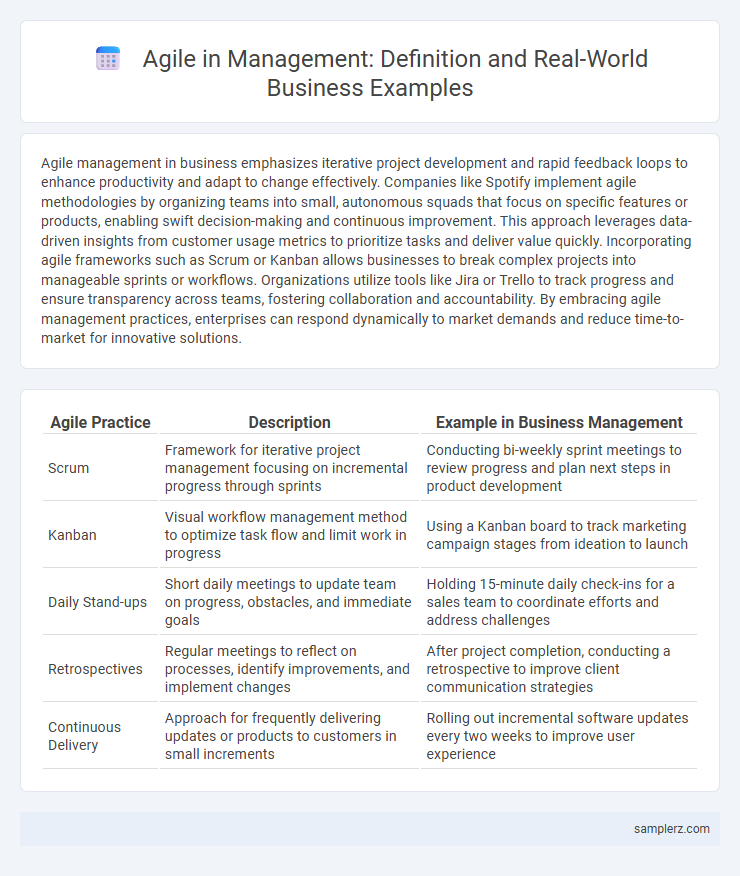Agile management in business emphasizes iterative project development and rapid feedback loops to enhance productivity and adapt to change effectively. Companies like Spotify implement agile methodologies by organizing teams into small, autonomous squads that focus on specific features or products, enabling swift decision-making and continuous improvement. This approach leverages data-driven insights from customer usage metrics to prioritize tasks and deliver value quickly. Incorporating agile frameworks such as Scrum or Kanban allows businesses to break complex projects into manageable sprints or workflows. Organizations utilize tools like Jira or Trello to track progress and ensure transparency across teams, fostering collaboration and accountability. By embracing agile management practices, enterprises can respond dynamically to market demands and reduce time-to-market for innovative solutions.
Table of Comparison
| Agile Practice | Description | Example in Business Management |
|---|---|---|
| Scrum | Framework for iterative project management focusing on incremental progress through sprints | Conducting bi-weekly sprint meetings to review progress and plan next steps in product development |
| Kanban | Visual workflow management method to optimize task flow and limit work in progress | Using a Kanban board to track marketing campaign stages from ideation to launch |
| Daily Stand-ups | Short daily meetings to update team on progress, obstacles, and immediate goals | Holding 15-minute daily check-ins for a sales team to coordinate efforts and address challenges |
| Retrospectives | Regular meetings to reflect on processes, identify improvements, and implement changes | After project completion, conducting a retrospective to improve client communication strategies |
| Continuous Delivery | Approach for frequently delivering updates or products to customers in small increments | Rolling out incremental software updates every two weeks to improve user experience |
Real-World Examples of Agile in Business Management
Spotify exemplifies agile management by utilizing squad-based teams that operate autonomously to rapidly develop features and respond to user feedback. ING Bank transformed its traditional hierarchy into agile squads, enabling faster decision-making and improved customer service in a competitive financial market. Amazon applies agile principles in its product development cycles, employing iterative testing and cross-functional teams to accelerate innovation and adapt to changing consumer demands.
Agile Project Management: Success Stories
Agile Project Management drives success through iterative development and adaptive planning, exemplified by Spotify's squad-based approach that increased team autonomy and innovation. ING's agile transformation reduced time-to-market by 40%, enhancing responsiveness in a competitive banking environment. These success stories underscore the effectiveness of Agile frameworks like Scrum and Kanban in delivering value and improving project outcomes.
How Agile Transformed Corporate Workflows
Agile transformed corporate workflows by introducing iterative project management, enabling teams to deliver value faster through continuous feedback and adaptive planning. Companies like Spotify and Microsoft adopted agile frameworks such as Scrum and Kanban to improve cross-functional collaboration, reduce bottlenecks, and enhance product development cycles. This shift resulted in increased productivity, higher customer satisfaction, and accelerated time-to-market for innovative solutions.
Case Study: Agile in Product Development
A leading software company implemented Agile methodologies in product development, resulting in a 30% reduction in time-to-market and a 40% increase in cross-functional team collaboration. By utilizing Scrum frameworks and iterative sprints, the company enhanced adaptability to customer feedback and rapidly delivered high-quality software updates. This case demonstrates Agile's effectiveness in accelerating innovation while maintaining product excellence in dynamic business environments.
Agile Practices in Strategic Planning
Agile practices in strategic planning emphasize iterative goal setting, continuous feedback integration, and rapid adaptation to market changes. Cross-functional teams collaborate in short planning cycles, allowing organizations to pivot strategies based on real-time data and stakeholder input. This approach enhances responsiveness and aligns strategic initiatives with evolving business objectives and customer needs.
Agile Teams: Empowering Managers for Success
Agile teams empower managers by fostering collaboration, flexibility, and rapid decision-making to drive project success. By implementing Scrum or Kanban methodologies, managers can effectively allocate resources, monitor progress, and adapt to changing business priorities. This approach enhances team productivity, accelerates product delivery, and ensures alignment with organizational goals.
Agile Implementation in Multinational Companies
Multinational companies implement Agile methodologies by fostering cross-functional teams that collaborate across time zones and cultures to accelerate product development and improve responsiveness to market changes. These organizations utilize tools like Jira and Scrum frameworks to enhance transparency, streamline workflows, and ensure continuous delivery of high-quality products. Successful Agile adoption in global enterprises often involves tailored training programs and leadership commitment to empower local teams while maintaining alignment with overall corporate objectives.
Measuring Business Success with Agile Methods
Agile methods measure business success by emphasizing iterative progress through key performance indicators such as customer satisfaction, time-to-market, and team velocity. Regular sprint reviews and retrospectives enable continuous feedback and adaptive planning, ensuring alignment with business goals. Data-driven metrics in Agile frameworks provide transparency and facilitate informed decision-making for optimizing overall organizational performance.
Overcoming Challenges in Agile Management
Overcoming challenges in agile management often involves addressing resistance to change by fostering a culture of continuous improvement and open communication among team members. Implementing regular sprint retrospectives allows teams to identify obstacles early and adapt workflows to enhance productivity and collaboration. Leveraging agile tools like Jira or Trello can also streamline project tracking, ensuring transparency and timely issue resolution throughout the development cycle.
The Future of Agile in Business Leadership
Agile management in business leadership prioritizes adaptive planning, continuous improvement, and rapid response to market changes, enhancing organizational resilience. Companies implementing frameworks like Scrum or Kanban achieve faster decision-making and improved team collaboration, driving innovation and customer satisfaction. Embracing agile principles positions leaders to navigate digital transformation and evolving business environments effectively.

example of agile in management Infographic
 samplerz.com
samplerz.com